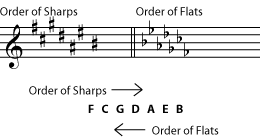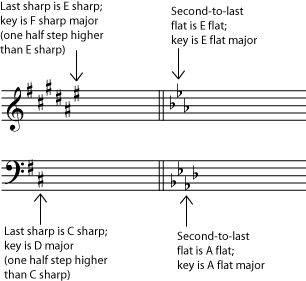

In musical notation, a key signature is a series of sharp symbols or flat symbols placed on the staff, designating notes that are to be consistently played one semitone higher or lower than the equivalent natural notes (for example, the white notes on a piano keyboard) unless otherwise altered with an accidental. Key signatures are generally written immediately after the clef at the beginning of a line of musical notation, although they can appear in other parts of a score, notably after a double bar.
The key signature comes right after the clef symbol on the staff. It may have either some sharp symbols on particular lines or spaces, or some flat symbols, again on particular lines or spaces. If there are no flats or sharps listed after the clef symbol, then the key signature is “all notes are natural”.
In common notation, clef and key signature are the only symbols that must appear on every staff. They appear so often because they are such important symbols; they tell you what note is on each line and space of the staff. The clef tells you the letter name of the note (A, B, C, etc.), and the key tells you whether the note is sharp, flat or natural.

The key signature is a list of all the sharps and flats in the key that the music is in. When a sharp (or flat) appears on a line or space in the key signature, all the notes on that line or space are sharp (or flat), and all other notes with the same letter names in other octaves are also sharp (or flat).

This key signature has a flat on the “B” line, so all of these B’s are flat.
The sharps or flats always appear in the same order in all key signatures. This is the same order in which they are added as keys get sharper or flatter. For example, if a key (G major or E minor) has only one sharp, it will be F sharp, so F sharp is always the first sharp listed in a sharp key signature.
The keys that have two sharps (D major and B minor) have F sharp and C sharp, so C sharp is always the second sharp in a key signature, and so on. The order of sharps is: F sharp, C sharp, G sharp, D sharp, A sharp, E sharp, B sharp. The order of flats is the reverse of the order of sharps: B flat, E flat, A flat, D flat, G flat, C flat, F flat. So the keys with only one flat (F major and D minor) have a B flat; the keys with two flats (B flat major and G minor) have B flat and E flat; and so on. The order of flats and sharps, like the order of the keys themselves, follows a circle of fifths.
The key signatures with seven flats and seven sharps are very rarely used, not only because pieces in these “extreme” sharp or flat keys are more difficult to play on most instruments, but also because they have simpler enharmonic equivalents. For example, the key of C# major (seven sharps) is more simply represented as Db major (five flats). For modern practical purposes these keys are the same, because C# and Db are the same note. Pieces are written in these “extreme” sharp or flat keys, however: for example, Bach’s Prelude and Fugue No. 3 from Book 1 of The Well Tempered Clavier BWV 848 is in C# major.

If you do not know the name of the key of a piece of music, the key signature can help you find out. Assume for a moment that you are in a major key. If the key contains sharps, the name of the key is one half step higher than the last sharp in the key signature. If the key contains flats, the name of the key signature is the name of the second-to-last flat in the key signature.

The only major keys that these rules do not work for are C major (no flats or sharps) and F major (one flat). It is easiest just to memorize the key signatures for these two very common keys. If you want a rule that also works for the key of F major, remember that the second-to-last flat is always a perfect fourth higher than (or a perfect fifth lower than) the final flat. So you can also say that the name of the key signature is a perfect fourth lower than the name of the final flat.

If the music is in a minor key, it will be in the relative minor of the major key for that key signature. If you cannot tell from the sound of the music if you are in a major or minor key, the best clue is to look at the final chord. That chord (and often the final note of the melody, also) will usually name the key. Problem 1 Write the following key signatures correctly and name the major keys that they represent:

However, the aforementioned 15 key signatures only express diatonic scales (and are therefore sometimes called “standard key signatures”). Other scales are written either with a standard key signature and use accidentals as required, or with a non-standard key signature, such as the Eb (right hand) and F# & G# (left hand) used for the Eb diminished (Eb octatonic) scale in Bartók’s “Crossed Hands” (no. 99, vol. 4, Mikrokosmos), or the Bb, Eb & F# used for the D Phrygian dominant scale in Frederic Rzewski’s God to a Hungry Child.
Here is a B major scale written with accidentals:
and here is the same scale (played on the same notes) written using a key signature:
The effect of a key signature continues throughout a piece or movement, unless explicitly cancelled by another key signature. For example, if a five-sharp key signature is placed at the beginning of a piece, every A in the piece in any octave will be played as A sharp, unless preceded by an accidental (for instance, the A in the above scale — the penultimate note — is played as an A# even though the A# in the key signature is written an octave lower).
Generally, if there is only one sharp, it must be F sharp; the sequence of sharps or flats in key signatures is rigid in music from the common practice period. The order is set out below. In the 20th century composers such as Bartók and Rzewski (see below) began experimenting with unusual key signatures which departed from the standard order.
In a score containing more than one instrument, all the instruments are usually written with the same key signature. Exceptions:
A key signature is not the same as a key; key signatures are merely notational devices. They are convenient principally for diatonic or tonal music. Some pieces which change key (modulate) insert a new key signature on the staff partway, while others use accidentals: natural signs to “neutralize” the key signature and other sharps or flats for the new key.
For a given mode the key signature defines the diatonic scale that a piece of music uses. Most scales require that some notes be consistently sharpened or flattened. For example, in the key of G major, the leading-note is F sharp. So the key signature associated with G major is the one-sharp key signature.
However, there is no causal connection; if you see a piece with a one-sharp key signature, you cannot be certain it is in G major. Many other factors determine the key of a piece. This is particularly true of minor keys. The famous “Dorian” Toccata and Fugue by Bach is so named because, although it is in D minor, there is no key signature, implying that it is in D Dorian. Instead, the B flats necessary for D minor are written as accidentals as and when necessary.
Two keys which share the same key signature are called relative keys.
When modes, such as Lydian or Dorian, are written using key signatures they are called transposed modes.
The table below illustrates the number of sharps or flats for each key signature and the relative major key signatures for minor scales (see circle of fifths). Remembering all the key signatures is easily done when you apply four simple rules:
(The relative minor is a minor third down from the major, regardless of whether it is a “flat” or a “sharp” key signature).
For key signatures with sharps, the first sharp is placed on F line (for the key of G major/E minor). Subsequent additional sharps are added on C, G, D, A, E and B. For key signatures with flats, the first flat is placed on the B line, with subsequent flats on E, A, D, G, C and F. A common mnemonic for remembering this is Father Charles Goes Down And Ends Battle (or Fat Cats Go Down Alleys Eating Birds) for key signatures with sharps, and vice versa for key signatures with flats: Battle Ends And Down Goes Charles’s Father. There are 15 possible different key signatures, including the “empty” signature of C major/A minor. This sequence is rendered in the circle of fifths.
Note that an absence of a key signature does not always mean that the music is in the key of C major or A minor: each accidental may be notated explicitly as required, or the piece may be modal, or the piece may be atonal.
| Key Sig. | Major Key | Minor Key |
|---|---|---|
| No sharps or flats | C major | A minor |
| Key Sig. | Major Key | Minor Key |
|---|---|---|
| 1 flat | F major | D minor |
| 2 flats | Bb major | G minor |
| 3 flats | Eb major | C minor |
| 4 flats | Ab major | F minor |
| 5 flats | Db major | Bb minor |
| 6 flats | Gb major | Eb minor |
| 7 flats | Cb major | Ab minor |
| Key Sig. | Major Key | Minor Key |
|---|---|---|
| 1 sharp | G major | E minor |
| 2 sharps | D major | B minor |
| 3 sharps | A major | F# minor |
| 4 sharps | E major | C# minor |
| 5 sharps | B major | G# minor |
| 6 sharps | F# major | D# minor |
| 7 sharps | C# major | A# minor |
The use of a one-flat signature developed in the Medieval period, but signatures with more than one flat did not appear until the 16th century, and signatures with sharps not until the mid-17th century. Baroque music written in minor keys often was written with a key signature with fewer flats than we now associate with their keys; for example, movements in C minor often had only two flats (because the Ab would frequently have to be sharpened to A natural in the ascending melodic minor scale, as would the Bb).